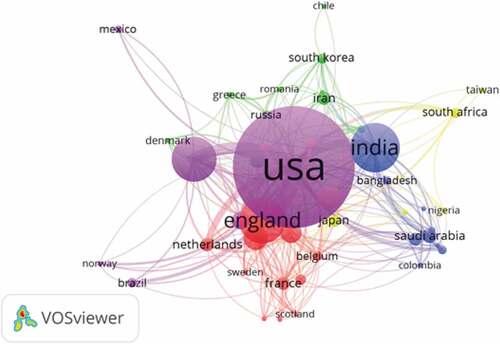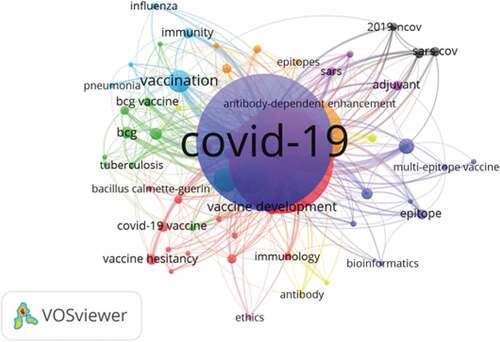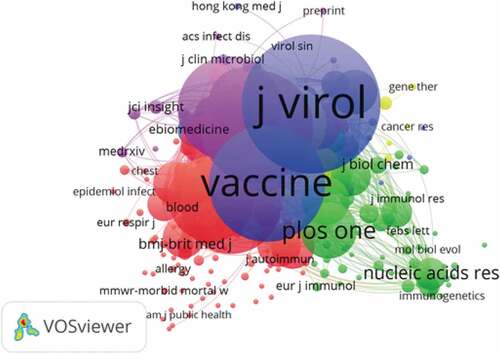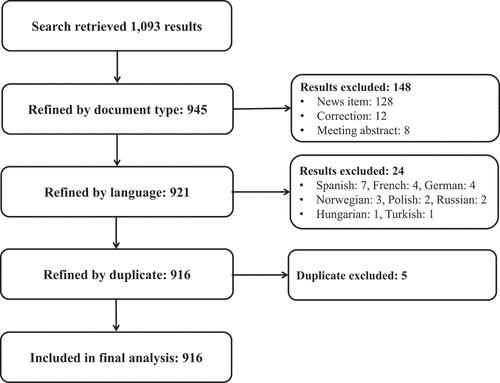ABSTRACT
Background: In the last two decades the world has experienced many outbreaks of infectious diseases including the coronavirus disease 2019 (COVID-19) pandemic. COVID-19 was first reported in China and spread to more than 200 countries and territories. At present, there are no available treatment and vaccines for COVID-19. This study aimed to evaluate the global research trends in COVID-19 vaccine.
Methods: On January 12, 2020, a comprehensive search of documents on COVID-19 was conducted in the Web of Science Core Collection database. HistCiteTM and VOSviewer softwares are used for citations and visualization mapping.
Results: A total of 916 documents authored by 4,392 authors and published in 376 journals were included in the final analysis. Majority of the retrieved documents consisted of articles (n = 372, 40.6%). The most prolific authors were Dhama K (n = 10, 1.1%) and Hotez PJ (n = 10, 1.1%). The most active institution was the University of Oxford (n = 24, 2.6%). The leading journal in COVID-19 vaccine was Human Vaccine & Immunotherapeutics (n = 43, 4.7%). The most frequently used keywords were COVID (n = 597, 65.2%), and vaccine (n = 521, 56.9%). Furthermore, visualization mapping shows that COVID-19 was the most co-occurrence author keyword. The United States of America (USA) was the most productive country, 352 (38.4%).
Conclusions: This is the first bibliometric study that provides detailed information about published literature on the COVID-19 vaccine. Majority of the publications were published in developed countries. The findings may useful for researchers and policymakers.
Introduction
During the past two decades several human coronaviruses have been identified, e.g., severe acute respiratory syndrome coronavirus (SARS-CoV) was first originated in China in November 2002, Middle East respiratory syndrome coronavirus (MERS-CoV) was emerged in Saudi Arabia in September 2012, and recently discovered novel coronavirus severe acute respiratory syndrome coronavirus 2 (SARS-CoV-2). The SARS-CoV-2 was first reported in China in December 2019.Citation1
SARS-CoV-2 induced the illness recognized as coronavirus disease 2019 (COVID-19), and caused ~100 M cases with ~2 M deaths worldwide.Citation1,Citation2 As a consequence of the advance of the COVID-19 pandemic, people are in a state of fear and uncertainty. The invention of vaccination against COVID-19 has given some hope to the world. COVID-19 pandemic has caused incalculable human misery and economic disruption.Citation3 Vaccination not only reduces the disease prevalence but also protect the unimmunized individuals of the community. Besides hygienic and behavioral management steps, immunization/vaccination is the most reliable means of reducing and ultimately preventing transmission of infectious diseases.Citation4 Furthermore, vaccine-preventable illnesses contribute significantly to the morbidity, mortality of adults and children and economic lost. Therefore, immunizations are considered to be one of the most successful prevention tools against infectious diseases.Citation5 Vaccination provides economical ways to reduce a burden of infectious diseases and associated treatment expenses.Citation6,Citation7
There is no proper treatment and vaccine available for COVID-19. Different kinds of COVID-19 vaccine candidates are under development, e.g., whole virus vaccine, subunit vaccine, and nucleic acid vaccine.Citation8
Since the discovery of SARS-CoV-2, research, and published literature have been increased rapidly to better understand different aspects of the disease, e.g., transmission, pathogenesis, treatment, diagnosis, and vaccine development. Therefore, several journals published special issues on SARS-CoV-2/COVID-19.Citation9
The primary objective of this article is to evaluate the global research trend in the COVID-19 vaccine. In addition to constructing visualization network mapping for co-authorship and country, co-occurrence and author keywords, and co-citation and cited sources.
Methods
On January 12, 2021, a comprehensive online search was conducted through the Web of Science Core Collection Database with keywords; TITLE: (corona* OR 2019-nCoV OR nCoV-19 OR SARS-CoV-2 OR SARS-CoV2 OR OR COVID*) AND TITLE: (vacc* OR immuniz*). The retrieved dataset were refined by document type, language, and duplication. The dataset’s main outcomes included authors, document type, journal, institution, country, and citations. The data were exported into Microsoft Excel 2013 for Windows (Microsoft Corp., Redmond, WA, United States of America, USA). The citation analysis was performed using HistCiteTM software (http://www.histcite.com/). For visualization mapping, VOSviewer software version 1.6.16 (http://www.vosviewer.com) was used. The visualization mapping was constructed for co-authorship country, co-occurrence author keywords, and co-citation cited sources. The flow chart of included publications is presented in .
Ethical consideration
Generally, in bibliometric type studies, there is no human and animal involvement; therefore, no ethical approval was required.
Results
The initial search resulted in 1,093 documents on SARS-CoV-2/COVID-19 vaccine. A total of 916 documents published on the COVID-19 vaccine were included in the final analysis. The published documents were authored by 4,392 authors and published in 376 journals with cited references 20,858, and 2,059 dominant words. The most prolific authors were Dhama K (n = 10, 1.1%) and Hotez PJ (n = 10, 1.1%), as described in . Among the total authors, 52 authors published at least 5 documents on the COVID-19 vaccine. Majority of the retrieved documents consisted of article (n = 372, 40.6%), followed by editorial material (n = 260, 28.4%), and review (n = 188, 20.5%) as shown in . The most active institution was the University of Oxford (n = 24, 2.6%), followed by Harvard Medical School (n = 17, 1.9%) and the University of Washington (n = 17, 1.9%), as presented in . Among the total institutions, only 18 institutions have published at least 10 documents on the COVID-19 vaccine. Only 13 journals published at least 10 documents. The journal with a maximum number of published documents was Human Vaccine & Immunotherapeutics (n = 43, 4.7%), followed by Vaccine (n = 38, 4.1%), and Lancet (n = 33, 3.6%) as described in . The most frequently used words were COVID (n = 597, 65.2%), and vaccine (n = 521, 56.9%) as presented in . Of the total countries, only 28 produced more than 10 documents on the COVID-19 vaccine. The USA was the most productive country with 352 (38.4%) published documents, followed by India (n = 112, 12.2%), United Kingdom (n = 110, 12%), and China (n = 100, 10.9%), as shown in .
Table 1. Top-10 most prolific authors
Table 2. Distribution of included publications by document type
Table 3. Top-10 active institutions
Table 4. Top-10 leading journals
Table 5. Top-10 frequently used words
Table 6. Top-10 most productive countries in COVID-19 vaccine
Co-authorship country
Publications coauthored by many countries were excluded, and the maximum number of countries per publication was set at 25. The minimum number of publications per country was fixed at 5. Of the 93 countries, only 44 meet the threshold. Weights based on documents USA were the leading country (documents = 354, citations = 3,294, total link strength (TLS) = 248), followed by India (documents = 113, citations = 480, TLS = 66), England (documents = 105, citations = 819, TLS = 121), and China (documents = 100, citations = 1,672, TLS = 79). Co-authorship country visualization network map is presented in .
Figure 2. Co-authorship country visualization network map. Only five clusters are formed; red color indicates Cluster 1 (11 countries: Austria, Belgium, England, Finland, France, Germany, Italy, Netherland, Scotland, Sweden, and Turkey); green color indicates Cluster 2 (10 countries: Chile, Denmark, Greece, Romania, Russia, Singapore, South Korea, Switzerland, and Thailand); blue color indicates Cluster 3 (9 countries: Bangladesh, Colombia, Egypt, India, Indonesia, Malaysia, Morocco, Pakistan, and Saudi Arabia); yellow color indicates Cluster 3 (8 countries: Canada, Israel, Japan, New Zealand, Nigeria, South Africa, Spain, and Taiwan); purple color indicates cluster 5 (6 countries: Australia, Brazil, Mexico, Norway, China, and USA)

Co-occurrence author keywords
The minimum number of occurrence of a keyword was set at 5. Of the total 1,173 keywords, only 61 keywords were processed. The dominant top three author keywords were COVID-19 (occurrences = 309, TLS = 695), SARS-CoV-2 (occurrences = 222, TLS = 569), and vaccine (occurrences = 142, TLS = 362). The co-occurrence of author keywords is presented in .
Figure 3. Visualization network map of author keywords co-occurrence. There are nine Clusters are formed weights based on occurrences. Red color represents Cluster 1 (14 words), green color represents Cluster 2 (11 words), blue color represents Cluster 3 (9 words), yellow color represents Cluster 4 (7 words), purple color represents Cluster 5 (6 words), light-blue represents Cluster 6 (5 words), orange color represents Cluster 7 (5 words), black color represents Cluster 8 (3 words), and pink color represents Cluster 9 (1 word)

Co-citation cited sources
The minimum number of citations of a source was set at 20. Of the total sources, only 217 sources meet the threshold. The Journal of Virology was the leading source with highest TLS 99,906 (citations = 1305), followed by Vaccine (TLS = 79,988, citations = 1,369), and Nature (TLS = 77,098, citations = 1,167). The co-citation and cited sources visualization map is presented in .
Figure 4. Visualization mapping of co-citation cited sources. There are five clusters formed; red color indicates cluster 1 (90 sources), green color indicates cluster 2 (57 sources), blue color indicates cluster 3 (31 sources), yellow color represents cluster 4 (21 sources), and purple color represents cluster 5 (18 sources)

Discussion
Bibliometric analysis is a very useful tool to evaluate and analyze scientific research output and trends. This is the first bibliometric study focused on COVID-19 vaccine research output and visualization mapping. After the emergence of SARS-CoV-2 the knowledge and information have been expanding at a high level. Thousands of documents have already been published on COVID-19.
Scientific research and data play a very crucial role in the early control and prevention of disease outbreaks and epidemics. It is of great interest to share the very early information with the public, researchers, government organizations, institutes, and as well as at national and international levels. Based on such kind of information, safety measurements and guidelines are being adopted. At the beginning of the COVID-19 outbreak, China has shared the available information on SARS-CoV-2 with other countries to develop early treatment and vaccines.
Like medical staff to fight against the COVID-19, academia joined this “battlefield” to provide useful suggestions and recommendations for policy-making and prevention. Many medical periodicals with good impact factors, including Lancet and New England Journal of Medicine, have also opened special issues on COVID-19 together all the available information and knowledge.Citation10
Our pre-search conducted in the Web of Science database with keywords COVID-19 OR SARS-CoV-2 in the title field yielded more than 60,000 documents published on COVID-19. The disease has gained vital importance across the globe. Before conducting this study, a search on bibliometric analysis in COVID-19 was performed. The search retrieved 27 publications, but no bibliometric study has been conducted on the COVID-19 vaccine. Therefore, the current study aimed to evaluate the overall global research output and visualization mapping of COVID-19 vaccine research. To the very best of our knowledge, this is the first bibliometric analysis in COVID-19 vaccine research.
In our study, a total of 916 publications on the COVID-19 vaccine were analyzed. In this study, the most frequent keyword and author co-occurrence keyword was COVID-19. The finding is in line with other studies.Citation11
The impact factor of top-10 journal ranges from 2 “Journal of Medical Virology” to 74.7 “New England Journal of Medicine”, and of which 6 journals are placed in Quartile 1 (Q1), 3 in Quartile 2 (Q2), and 1 is in Quartile 4 (Q4). The finding shows that, the authors targeted top journals. The most prolific authors in COVID-19 vaccines research are from India (Dhama K) and USA (Hotez PJ). In scientific writing and publishing editorials, short reports, and commentaries has gained more attentions, and considered to be one of the most informative documents for early information.
The most productive country was the USA. According to an early bibliometric analysis, the leading country in COVID-19 was China, which might be one of the reasons that the disease was first emerged in China. But after a few months later, the publications trends and COVID-19 tendency was shifted at a large number to Europe and USA. Currently, USA has a high number of COVID-19 cases. Most scientists, researchers, and institutes are truly focusing on COVID-19 with a particular interest in treatment and vaccine development.
Conclusions
This is the first bibliometric study that provides detailed information about published literature on the COVID-19 vaccine. Over the time number of papers on the COVID-19 vaccine has been increased. The most active institution was the University of Oxford, and the most productive country was the USA. The most frequently co-occurrence author keyword was COVID-19. The findings of this study can be helpful for researchers, policymakers, and educational aims. It is also helpful for funding agencies to assess ongoing research and future research trends in COVID-19 vaccines. Effective vaccine development and treatment therapy is still a hot zone for future research directions.
Author’s contributions
TA: Study design, methodology, data collection, software, formal analysis, and wrote the first draft. TA, MAM, MB, and JH: Reviewed and edited the final draft. All the authors are agreed and approved the final manuscript for publication.
Disclosure of potential conflicts of interest
No potential conflicts of interest were disclosed.
Acknowledgments
The authors are very thankful to Southeast University China for providing free online access to Web of Science Core Collection database. We also acknowledge the critical review of unknown reviewers.
Additional information
Funding
References
- Ahmad T, Shah MW, Ahmad H, Khan M. Coronavirus disease 2019 (COVID-19); Perspective of Pakistan. J Pure Appl Microbiol. 2020;14(suppl 1):699–701. doi:10.22207/JPAM.14.SPL1.03.
- COVID-19 dashboard by the center for systems science and engineering (CSSE) at John Hopkins University & Medicine. COVID-19 Dashboard by the Center for Systems Science and Engineering (CSSE) at John Hopkins University & Medicine. [Accessed 2021 January 13]. https://coronavirus.jhu.edu/map.html
- Ahmad T, Haroon,Baig M, Hui J. Coronavirus disease 2019 (COVID-19) pandemic and economic impact. Pak J Med Sci. 2020;36(COVID19–S4):S73–S78. doi:10.12669/pjms.36.COVID19-S4.2638. PMID: 32582318.
- Pogue K, Jensen JL, Stancil CK, Ferguson DG, Hughes SJ, Mello EJ, Burgess R, Berges BK, Quaye A, Poole BD. Influences on attitudes regarding potential COVID-19 vaccination in the United States. Vaccines (Basel). 2020;8(4):582. doi:10.3390/vaccines8040582. PMID: 33022917.
- Andre FE, Booy R, Bock HL, Clemens J, Datta SK, John TJ, Lee BW, Lolekha S, Peltola H, Ruff TA, et al. Vaccination greatly reduces disease, disability, death and inequity worldwide. Bull World Health Organ. 2008;86(2):140–46. doi:10.2471/blt.07.040089. PMID: 18297169.
- Orenstein WA, Ahmed R. Simply put: vaccination saves lives. Proc Natl Acad Sci USA. 2017;114(16):4031–33. doi:10.1073/pnas.1704507114. PMID: 28396427.
- CDC. Epidemiology and prevention of vaccine-preventable diseases 13th ed. Washington (DC): Public Health Foundation; 2015.
- Chen WH, Strych U, Hotez PJ, Bottazzi ME. The SARS-CoV-2 vaccine pipeline: an overview. Curr Trop Med Rep. 2020;7:61–64. doi:10.1007/s40475-020-00201-6. PMID: 32219057.
- Afshar A, Tabrizi A. Bibliometric analysis of the100 highly-cited articles about COVID-19. Arch Bone Jt Surg. 2020;8(6):748–56. doi:10.22038/abjs.2020.51846.2556. PMID: 33313359.
- Brown A, Horton R. A planetary health perspective on COVID-19: a call for papers. Lancet Planet Health. 2020;4(4):e125. doi:10.1016/S2542-5196(20)30078-4. PMID: 32251644.
- Yu Y, Li Y, Zhang Z, Gu Z, Zhong H, Zha Q, Yang L, Zhu C, Chen E. A bibliometric analysis using VOSviewer of publications on COVID-19. Ann Transl Med. 2020;8(13):816. doi:10.21037/atm-20-4235. PMID: 32793661.

